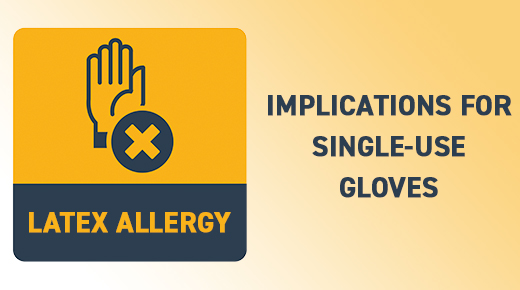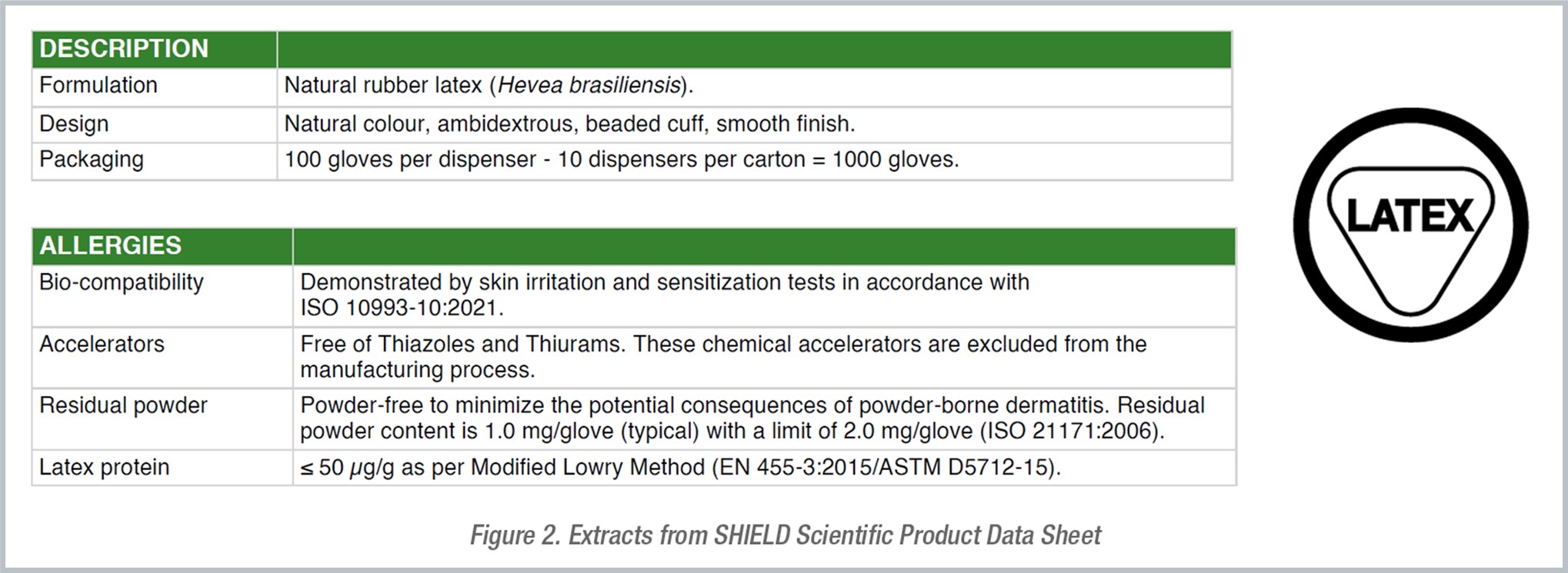LATEX ALLERGY (Type I) AND ITS IMPLICATIONS FOR SINGLE-USE GLOVES

Protecting yourself and your hands is essential in many professional settings. More than 400 billion disposable gloves are used worldwide every year (MARGMA- Malaysian Rubber Glove Manufacturers Association) and this figure is constantly increasing due to widespread awareness about workers’ hygiene, cleanliness, and safety.
But wearing single-use gloves is not harmless. With the sharp increase in the use of disposable gloves, it is not surprising that there is an increased risk of allergic reactions. Among these reactions is an allergy to Natural rubber latex or Type I allergy related to single-use gloves made of Natural rubber latex. Whilst a Type I allergic reaction is rare in comparison to all other glove-associated reactions, the fact remains that it can have very serious health consequences such as mortality arising from anaphylactic shock.
It is therefore important to understand the mechanism of allergic reactions and especially those concerning allergy to natural latex (Type I). In this way users of single-use gloves can implement measures for limiting the risk of allergic reactions by selecting the appropriate glove.
WHERE DOES THE NATURAL RUBBER LATEX USED IN THE MANUFACTURE OF DISPOSABLE GLOVES COME FROM?
Latex – a natural material
Latex is a natural raw material originating from a tree named Hevea or Hevea brasiliensis. This tree has been cultivated for decades in South-east Asia. To date, it is the main commercial source of natural latex. It is also the primary raw material used in the manufacture of single-use gloves. This explains why glove manufacturing plants, which require heavy investments and a large workforce, are still mainly located in this part of the world (65% of disposable gloves are produced in Malaysia, 20% in China, 10% in Thailand and 3% in Indonesia).
The unique characteristics of natural rubber latex of excellent elongation properties, comfort and low cost have long made it the preferred material for the manufacturing of single-use gloves.
The harvesting of natural rubber latex is carried out by repeatedly cutting the bark of the tree. A milky liquid then flows from the incisions to containers. The natural latex is filtered and then centrifuged to extract the water and thus obtain a concentrated paste.
Latex – a raw material used to produce many objects
Some studies show that about 4.3% of the world’s population is potentially allergic to natural rubber latex (https://www.ncbi.nlm.nih.gov/pmc/articles/PMC5356959/). Natural rubber latex objects are numerous (various medical devices, condoms, balloons, baby-bottle nipples, some paints …) and sensitivity to natural rubber latex has become more and more significant over time.
Care and healthcare workers, who regularly wear single-use gloves and especially latex gloves (even if consumption is decreasing in favor of synthetic gloves) are however particularly exposed with a prevalence rate of as much as 9.7% (not to mention sensitive patients who would be around 7.2%). But all wearers of disposable latex gloves, whether for example in the Laboratory, the cleanroom or any other industrial sector are potentially concerned by the risk of an allergic reaction to natural latex.
The impact of allergic reactions to natural latex on the health of workers but also on the organization is no small matter and entails significant costs (related to screening, treatment, work stoppages and care for those affected).
WHAT IS AN ALLERGIC REACTION TO NATURAL LATEX?
Remember that the main reactions related to wearing single-use gloves are:
- Irritant contact dermatitis
- Allergic contact dermatitis (Type IV)
- Allergy to Natural Rubber Latex (Type I)
Latex allergy or more precisely latex protein allergy is also called Type I allergy or immediate type hypersensitivity because it usually occurs between a few minutes to 1 hour after contact with the allergen. It is a specific allergy related to the production of immunoglobulin E (IgE) which are antibodies triggering an immediate allergic response.
When does latex allergy occur?
Initial exposure to latex protein may have entailed an abnormal (but often invisible) immune reaction; then an allergic reaction may occur during a second exposure.
Cross-reactions with certain foods that also contain proteins found in Latex (avocado, apple, tomato, banana, cherries, kiwi …) may also occur. People who have a known allergy to certain foods must be particularly careful when using natural rubber latex objects including disposable latex gloves.
What are the main symptoms of an allergic reaction to natural rubber latex?
These symptoms are of several types with different levels of seriousness. The consequences can indeed be moderate but can also extend to life-threatening reactions:
- Skin conditions: Itching, tingling, mild and local or extensive contact dermatitis over a large part of the body, urticaria.
- Digestive disorders: nausea, vomiting.
- Breathing problems: chest tightness, asthma, dyspnea.
- Anaphylactic shock with constriction of the airways, swelling of the mucous membranes (angioedema for example), drop in blood pressure …
HOW TO MANAGE ALLERGIC REACTIONS RELATED TO WEARING DISPOSABLE GLOVES?
Natural latex is not the only source of allergic reaction to wearing single-use gloves. Mention should be made of the chemicals entering the manufacturing processes (vulcanization accelerators for example), the powder used to facilitate the release of gloves from the mould or to facilitate glove donning by users, endotoxins … Possible skin diseases should also be considered as a risk factor for developing allergic reactions. Finally, the conditions of use need to be considered such as extended wearing of disposable gloves, frequent hand washing, products in contact with the hands (detergents, disinfectants …) …
What to do if a Type I allergic reaction is suspected in the workplace?
Priority should be given to quickly informing your supervisor and the occupational health service.
It is advisable to immediately replace the natural latex gloves with synthetic gloves (nitrile gloves) and preferably non-powdered.
An allergy specialist should be consulted to confirm the presence or not of the suspected Type I allergic reaction. He / She will undertake careful medical questioning followed by tests to find the origin of the allergic reaction. Self-injectable adrenaline may also be prescribed to always keep on you in case of a confirmed allergy to natural rubber latex.
It is also recommended to inform those around you (HR, colleagues but also dentist etc.).
How to select the appropriate single-use glove?
While allergic reactions tend to increase, especially in the laboratory sector due to a heavy use of single-use gloves, it is recommended to limit the specific risks of allergy to natural rubber latex (type I) by wearing gloves containing low levels of latex protein, powder-free gloves or synthetic gloves (https://www.hse.gov.uk/healthservices/latex/).
To select a single-use glove, it is strongly recommended to consult the technical data provided by the manufacturer.
SHIELD Scientific as a nitrile and latex gloves manufacturer, specifies the materials used as well as the potential sources of allergies in all the Technical Data Sheets of its gloves:
- Use or not of accelerators during the vulcanization process.
- Powder-free or mention of powder content level.
- Latex protein content according to the modified Lowry method and certified by an independent laboratory.
- Biocompatibility tests to ensure that the glove material won’t cause adverse reactions.
To conclude, taking care of your health and your hands entails understanding better the causes of allergic reactions and the risks related to the wearing of disposable gloves. However, other risk factors should not be underestimated (soaps, disinfectants, skin creams, etc.) as well as the residues of chemicals that may contribute to the development of allergic reactions, including Type IV allergic reactions that we will discuss in a future article.
Minimizing the risk of immediate type hypersensitivity (Type I) to natural rubber latex requires selecting quality gloves from a reputable manufacturer and noting the composition of the gloves, chlorination methods (single or double) and the care taken by the manufacturer in washing the gloves. To select the right gloves adapted to your needs and budgets, consult the Technical Data Sheets of SHIELD Scientific Natural Latex and Nitrile gloves, or use our glove selection guide.
Do not hesitate to contact us for any further request.
Share this interesting information


